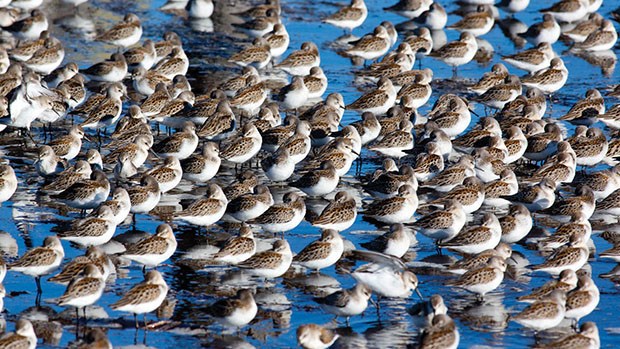This is the time of year that over a million shorebirds visit local beaches as they head north for the nesting season.
The smallest sandpipers, collectively known as "peeps," are tiny birds, each weighing only as much as a granola bar. Individual birds are easily overlooked since their brownish-grey plumage blends with the mud. A large flock is much more noticeable, especially when it performs amazing aerial displays.
Peeps fly 11,000 kilometres on migration from their wintering areas in South America to their breeding grounds in Alaska, and the Fraser delta is one of only a few major stopovers en route. It is essential the mud and sand flats of Boundary Bay, Roberts Bank and Sturgeon Banks, the three main components of the outer delta, remain viable habitat.
According to a 2014 study by Environment Canada and Bird Studies Canada, it is possible the entire Pacific Flyway population of western sandpiper and Dunlin may be found on the Fraser River delta during migration. The study authors calculated that 600,000 western sandpiper and 200,000 to 250,000 Dunlin, another sandpiper species, stop to feed just at Roberts Bank, with similar numbers occurring on Boundary Bay and Sturgeon Banks.
Each bird may stay only two to three days, foraging and roosting, before pressing on with its journey. Many other species of shorebird also stopover at these important habitats, most migrating northward in April and southward between July and October.
Sandpipers feed by probing in the mud for small creatures or by sucking up biofilm from the surface. If disturbed, they try and resettle just a few metres along to resume their feeding.
With the tide going out, the shorebirds become very spread out and distant, and can be difficult to observe. However, when the tide turns, the incoming water coaxes the feeding birds closer and closer to shore. With no more mud exposed, the birds sleep, preen and relax, restoring their energy for the kilometres to come.
At this time, they are very vulnerable to attack from falcons and eagles and disturbance by dogs and humans.
Join Against Port Expansion (APE) which is organizing a "Peep In" on the Brunswick Point dike on Saturday, April 25 at 10 a.m. to enjoy the shorebirds, support habitat protection and draw attention to the effects of the proposed port expansion.
Anne Murray is a local naturalist and writer. Her books on Delta's natural and ecological history, A Nature Guide to Boundary Bay and Tracing Our Past, a Heritage Guide to Boundary Bay, are available in local stores or from www.natureguidesbc.com. She blogs at www.natureguidesbc.wordpress.com.



